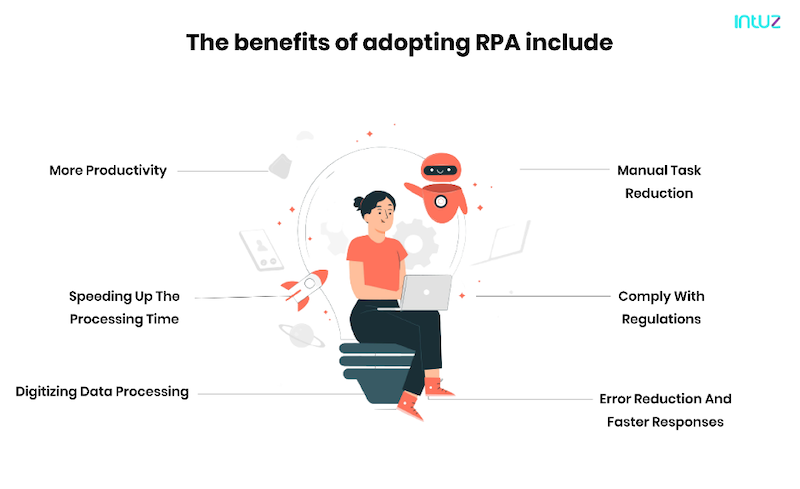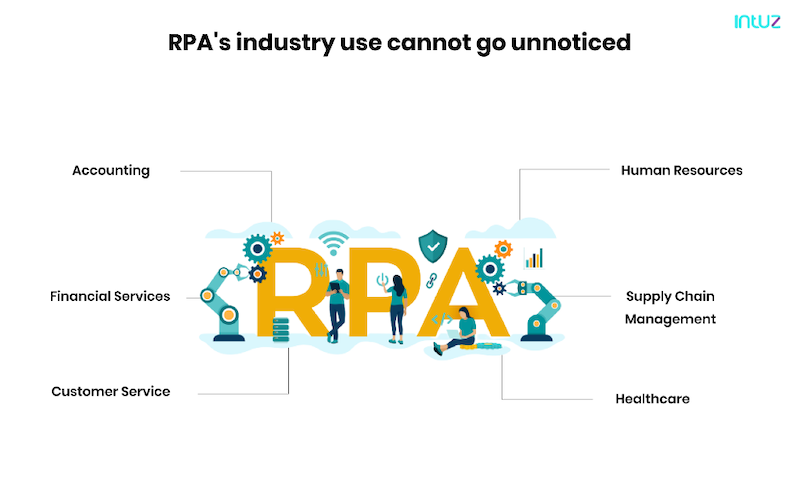
RPA with IoT: Paving the way for digital transformation
RPA, along with IoT, is the critical lever of modernization and process improvement. The combined technologies contribute to the digital transformation journeys of businesses.
This article dissects what RPA is, its use cases, and how it perfectly complements IoT technologies’ characteristics to help companies boost efficiency and drive higher profitability.
The term’ digital transformation’ has been creating a buzz in our world for a while now and it is primarily based on new digital technologies that allow businesses to improve their productivity, flexibility, and responsiveness in markets with global competition.
This happens through shorter production lead times allowing businesses to bridge the gap between supply and customer demand faster. Digital transformation has taken precedence far and wide, as evidenced by the following figures:
• The digital transformation market is expected to grow to $3.3 billion by 2025.
• 40% of executives agree that digital transformation has improved their operational efficiency.
• 44% of all companies have already adopted a digital-first business strategy, and 89% of them plan to do so.
Industry 4.0 comprises many considerable innovation families, among which both Internet of Things (IoT) and Robotic Process Automation (RPA) are considered essential levers of process improvement and modernization.
What is RPA?
It refers to a technology that can mimic human activity to perform repetitive, high-volume tasks quickly and with 100% accuracy. When coupled with IoT devices, RPA can respond automatically to data insights and perform tasks without being prompted.
Another advantage of using RPA software is that businesses can deploy it without learning new tools, asking IT teams for support, or entirely changing their underlying IT infrastructure, which could be extremely tedious and, of course, mighty expensive.
From insurance and banking to healthcare and supply chain, RPA has significant applications (just like IoT) concerning bringing costs down, streamlining processes, and enhancing interactions with customers.
Let us take a closer look at the role RPA plays in today’s rapidly digitizing world but first, let us take a step back and understand the underlying issues.
Challenges faced by IoT in transforming the digital world
The IoT ecosystem presents manifold opportunities for industries across sectors. However, there remain specific fundamental challenges to implementing it on a broad scale. These include:
1. Technology
As of today, many IoT development solutions remain poorly designed and come with complex configurations. IoT engineers also have limited resources when it comes to implementing and managing these systems, which hinders their maturity as a business process.
There is also a significant lack of authorization and standardization for IoT devices, including poorly defined auditing processes. There are no standard protocols for responses to incidents, which often leads to delays as engineers try to figure things out ad hoc.
2. Connectivity
Centralized systems are sufficient to handle multiple connected nodes up to the hundreds or even the thousands. However, in large IoT networks, up to millions of devices are connected at once and that can put a lot of load on the infrastructure.
It thus requires significant expense to build servers large enough to handle this load, and even then, we might see frequent server downtime.
An alternative would be to decentralize IoT networks, but this has its challenges concerning the division of functions and how to decide which devices/mini-networks are authorized to be part of the network.
3. Security
This remains one of the biggest obstacles to widespread IoT acceptance, as more connected devices mean more scope for hackers to breach systems. This is especially true in cases where security protocols are not clearly defined.
Given that cybersecurity breaches have been on the rise for a while, companies will be all the more reluctant to adopt systems that facilitate breaches.
Plus, as more and more of our devices become interconnected, our private information (such as medical data) becomes vulnerable to attack as well.
Integrating RPA into a business environment
The RPA technology can be invaluable to businesses on their digital transformation journeys. The benefits of adopting RPA include:

• Enabling employees to be more productive
• Helping business processes comply with regulations
• Speeding up processing time by a significant amount
• Digitizing data processing and thus enhancing efficiency
• Reducing the need to perform repetitive tasks manually
• Helping maintain better customer relations through error reduction and faster responses
RPA’s industry use cannot go unnoticed
The technology is currently used widely across multiple industries. Let us take a look at some of its applications:

1. Accounting
Firms use RPA to help with their budgeting, transactional reporting, operational accounting, and general accounting.
2. Financial services
RPA has multiple applications to manage audit requests, complete foreign exchange payments, process insurance claims, and automate account opening and closure. It helps boost their speed and efficiency to compete with fintechs.
3. Customer service
This significant function for any business and industry can be smoothened to a large extent by quickly scanning and verifying necessary documents, verifying e-signatures, and automating contact center activities.
4. Human resources
Daily HR tasks such as leave approval, claims processing, uploading/changing employee information, and on-boarding/off boarding can be delegated to RPA.
5. Supply chain management
Order procurement, automated payments and order confirmation, shipment tracking, and inventory monitoring are ideal for RPA.
6. Healthcare
Companies often use RPA to handle the technical side of things, such as processing bills, maintaining patient records, updating patient contact information, and managing customer support. This helps pursue back office and revenue cycle management uses, among others.
Opportunities offered by both IoT and RPA
Despite the plethora of benefits both technologies bring to the table, businesses still hesitate to take a leap of faith unless they have reviewed the technical feasibility, business use relevance, and economic viability of the project.
The good news is the complementarity characteristics of RPA and IoT are illustrated by several use-cases within Industry 4.0, including:
1. Supply chain management
Connected devices enable the real-time collection of data related to current levels of a variable, such as quantity or temperature, and correlating it with consumption patterns to develop control automation scenarios for the proactive replenishment of those variables.
For instance, IoT sensors can pick up data on customer orders concerning available stocks in a product warehouse and send out automated alerts for stock replenishment at periodic intervals.
The use of IoT enables fast, proactive, and automated responses to a variety of scenarios and frees up supply chain managers to focus on tasks like personalized customer interactions or advanced value-chain decision-making that require human intervention.
2. Predictive maintenance
Conducting maintenance work on factory equipment disrupts the normal flow of work and can adversely affect business continuity. With IoT sensors, however, companies can keep track of how their machines are performing in real-time.
The sensors can process data to identify early signs of wear and tear and predict conditions that could damage. This way, repair work can be done at the earliest stages when it requires less time and effort, which ensures that production can resume as quickly as possible.
This helps boost productivity levels, maintain output and service quality, reduce the need for manual inspection and push new product lines out faster.
RPA and digital transformation: a new reality
Digital transformation is not merely about cutting costs — it is a holistic journey that requires an ecosystem perspective.
To that extent, RPA needs to fit into the broader digital transformation strategy, which requires the company to understand its own goals and how automation can help clarify.
Merely adding RPA for its own sake may not be beneficial and may, in fact, become more of an expense than anything else.
Truly effective transformation requires a concrete plan, a phased introduction of technology such as RPA, and constant vigilance to ensure that results are coming along as planned.
Companies that invest in this process from the get-go will see the ROI and results they were aiming for. What do you think?


